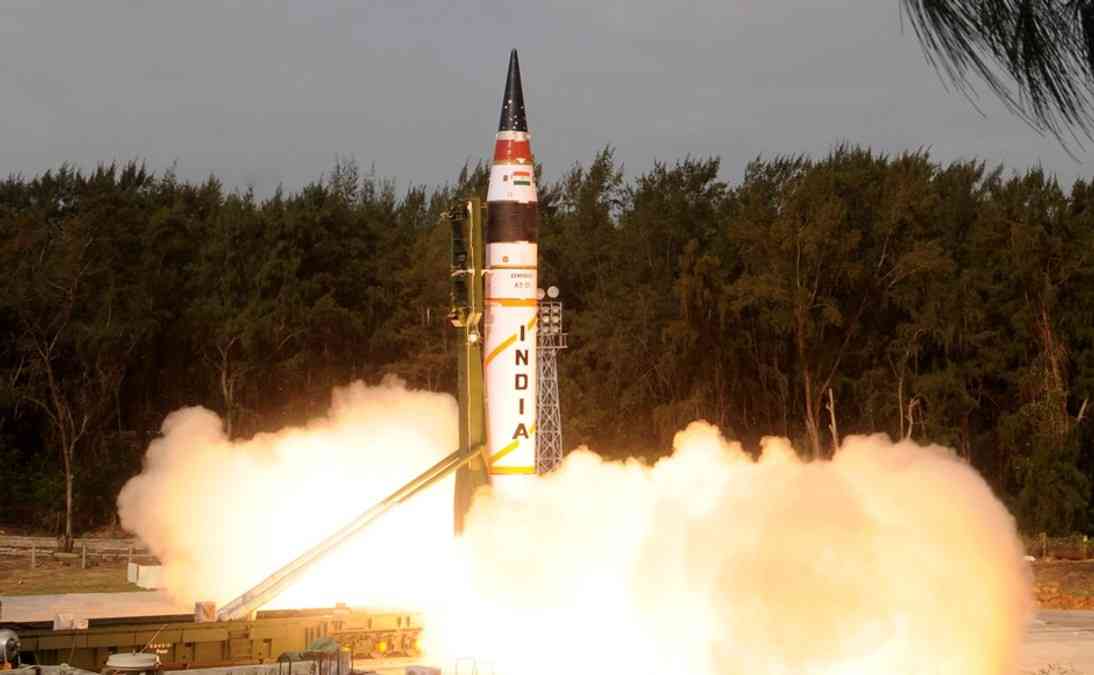Shakespeare famously stated, “sound and fury, signifying nothing.” The epitaph aptly describes the hollow core of India’s defence modernisation, driven solely by a ‘prestige rationale.’ On 20 August, in a bid to showcase its military prowess, New Delhi tested the indigenously developed, nuclear-capable Agni-V ballistic missile from an island off the coast of Odisha. The Defence Ministry remarked that the ‘launch validated all operational and technical parameters.’ However, beneath this bureaucratic jargon lies a deeper truth: the Agni-V’s evolving identity, from an intercontinental deterrent of global reach to a China-specific missile and now a supposed bunker-buster variant. This missile seems to be looking for a purpose, aptly reflecting New Delhi’s psyche of developing technology first and searching for where it fits later.
At the centre of this quagmire lies Agni-V’s range. As per the latest official statements, the Agni-V missile possesses a strike range of 5,000 km, thereby qualifying it as an Intermediate-Range Ballistic Missile (IRBM), a claim many analysts disagree with. Notably, India has downplayed its earlier projected range of 8,000 km, which would clearly classify it as an Intercontinental Ballistic Missile (ICBM). This operational range extends far beyond China, capable of reaching deep into Europe, Africa, and even parts of North America. Therefore, the new asserted range is not straightforward.
The development of nuclear ICBMs represents a strong manifestation of ‘global’ power projection; therefore, fearing an international backlash, Agni-V was rebranded as a ‘China-centric system.’ This also conveniently fits into their narrative of India being a ‘responsible nuclear power.’ Hence, euphemistically, a declared 5,000 km range acted as a rhetorical shield. It exemplifies India’s tendency to showcase capability theatrically while leaving its strategic purpose undefined.
When this proved untenable and its stated rationales seemed to lose credibility, India once again attempted to rebrand the missile. With nuclear thresholds tightening and Beijing’s deep defences and strategic depth reducing the plausibility of a credible deterrent, the script has now shifted to a more convenient storyline. Recent reports suggest an upgrade in the design, which would enable the Agni-V to carry a 7,500 kg high-powered conventional bunker-buster warhead, a seemingly palatable justification for the same hardware. According to Indian assessments, this modification would allow it to penetrate 80-100 metres underground before detonation, destroying deeply buried, hardened targets. Traditionally, the Agni-series missile has had a clear nuclear role. However, this new guise makes it more Pakistan-focused. In effect, it is a classic case of nuclear-conventional entanglement aimed at testing Islamabad’s nuclear threshold. An additional issue is the Circular Error Probability (CEP) of this long-range missile, which is unlikely to be as accurate as would be required for a bunker buster role.
The Agni series of missiles as a whole has suffered high-profile setbacks, from failed launches to aborted trials. Similarly, Agni-V has been tested repeatedly, often at moments of regional tensions, since its first flight in April 2012. Additionally, analysts suggest that the Surya ICBM, which was first announced in 1999, quietly faded from discourse, only to re-emerge years later under the Agni label. This highlights how India reshapes narratives and rebrands its defence projects to suit shifting strategic or political contexts.
This repeated redefining of the operational role of this missile questions whether the Agni is meant for nuclear deterrence, conventional precision strikes, or is mere symbolism for a prestige-driven agenda? The answer lies in the fact that India’s military modernisation is propelled not by strategy or careful assessment, but by a reflex to flaunt technology before rationalising its true purpose and place.
Ironically, this pattern is not new and is reflective of India’s wider defence landscape. For instance, the faltering Tejas fighter jet, the delayed Advanced Medium Combat Aircraft (AMCA), the troubled nuclear submarine programme, and the ambitious air defence claims are all Indian military programmes that have all been marked by lofty timelines and tall claims. These much-hyped, self-congratulatory ventures serve as India’s self-affirmation of its Atmanirbhar Bharat vision, yet offer no reasonable justification for the programmes themselves.
Conclusively, India clearly lacks a single coherent purpose for the Agni and appears to be manufacturing plausible stories around whatever role best projects power at that moment in time. In essence, New Delhi’s technological leaps are less about defensive necessity and more about signalling and industrial showmanship. India’s technological triumphs remain hollow trophies of prestige. New Delhi has continuously been inflating its weapons roles to fit political desires; a global ICBM one year, China-only deterrent the next, conventional bunker-buster thereafter, which makes for good headlines but poor strategy. Power is not proved by naming; it is proved by having a clear doctrine, credible capability, and the discipline to match means to ends.

Sibra Waseem
Sibra Waseem is a Research Assistant at the Centre for Aerospace and Security Studies (CASS), Lahore. She can be reached at info@casslhr.com.
- This author does not have any more posts.













